NUR250: Medical Surgical Nursing 2, Assessment 1: COPD Patient Care
VerifiedAdded on 2023/04/20
|10
|3595
|447
Report
AI Summary
This report presents a comprehensive care plan for a 44-year-old male patient, Mr. Peter Newman, admitted with an infective exacerbation of Chronic Obstructive Pulmonary Disease (COPD). The assignment addresses holistic patient care, emphasizing the application of the clinical reasoning cycle. The report begins by considering the patient's condition, including breathing difficulties, lifestyle modifications, emotional support, and patient education. It identifies and justifies three priority nursing assessments: airway patency, breathing patterns, and ability to perform activities of daily living. The report also outlines three priority nursing diagnoses: impaired gas exchange, deficient knowledge, and activity intolerance, explaining their relevance to the case. Furthermore, the assignment details specific patient education strategies for managing COPD post-discharge, covering breathing exercises, smoking cessation, medication management, and activity limitations. Finally, it defines the roles of allied health team members, including nurses, doctors, dietitians, counselors, and social workers, in providing comprehensive care. This detailed care plan aims to improve the patient's quality of life and overall health outcomes.
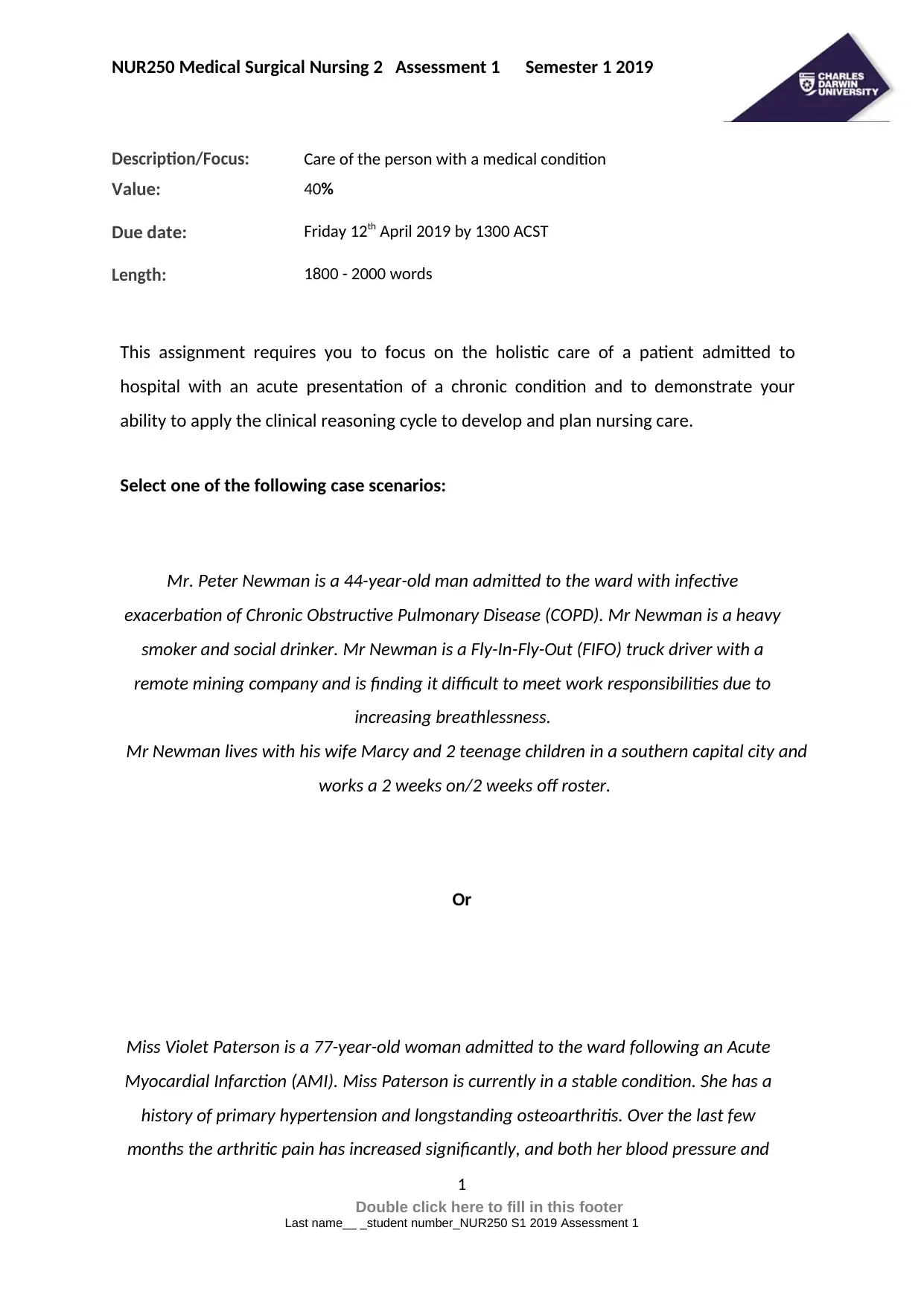
NUR250 Medical Surgical Nursing 2 Assessment 1 Semester 1 2019
Description/Focus: Care of the person with a medical condition
Value: 40%
Due date: Friday 12th April 2019 by 1300 ACST
Length: 1800 - 2000 words
This assignment requires you to focus on the holistic care of a patient admitted to
hospital with an acute presentation of a chronic condition and to demonstrate your
ability to apply the clinical reasoning cycle to develop and plan nursing care.
Select one of the following case scenarios:
Mr. Peter Newman is a 44-year-old man admitted to the ward with infective
exacerbation of Chronic Obstructive Pulmonary Disease (COPD). Mr Newman is a heavy
smoker and social drinker. Mr Newman is a Fly-In-Fly-Out (FIFO) truck driver with a
remote mining company and is finding it difficult to meet work responsibilities due to
increasing breathlessness.
Mr Newman lives with his wife Marcy and 2 teenage children in a southern capital city and
works a 2 weeks on/2 weeks off roster.
Or
Miss Violet Paterson is a 77-year-old woman admitted to the ward following an Acute
Myocardial Infarction (AMI). Miss Paterson is currently in a stable condition. She has a
history of primary hypertension and longstanding osteoarthritis. Over the last few
months the arthritic pain has increased significantly, and both her blood pressure and
1
Double click here to fill in this footer
Last name__ _student number_NUR250 S1 2019 Assessment 1
Description/Focus: Care of the person with a medical condition
Value: 40%
Due date: Friday 12th April 2019 by 1300 ACST
Length: 1800 - 2000 words
This assignment requires you to focus on the holistic care of a patient admitted to
hospital with an acute presentation of a chronic condition and to demonstrate your
ability to apply the clinical reasoning cycle to develop and plan nursing care.
Select one of the following case scenarios:
Mr. Peter Newman is a 44-year-old man admitted to the ward with infective
exacerbation of Chronic Obstructive Pulmonary Disease (COPD). Mr Newman is a heavy
smoker and social drinker. Mr Newman is a Fly-In-Fly-Out (FIFO) truck driver with a
remote mining company and is finding it difficult to meet work responsibilities due to
increasing breathlessness.
Mr Newman lives with his wife Marcy and 2 teenage children in a southern capital city and
works a 2 weeks on/2 weeks off roster.
Or
Miss Violet Paterson is a 77-year-old woman admitted to the ward following an Acute
Myocardial Infarction (AMI). Miss Paterson is currently in a stable condition. She has a
history of primary hypertension and longstanding osteoarthritis. Over the last few
months the arthritic pain has increased significantly, and both her blood pressure and
1
Double click here to fill in this footer
Last name__ _student number_NUR250 S1 2019 Assessment 1
Paraphrase This Document
Need a fresh take? Get an instant paraphrase of this document with our AI Paraphraser
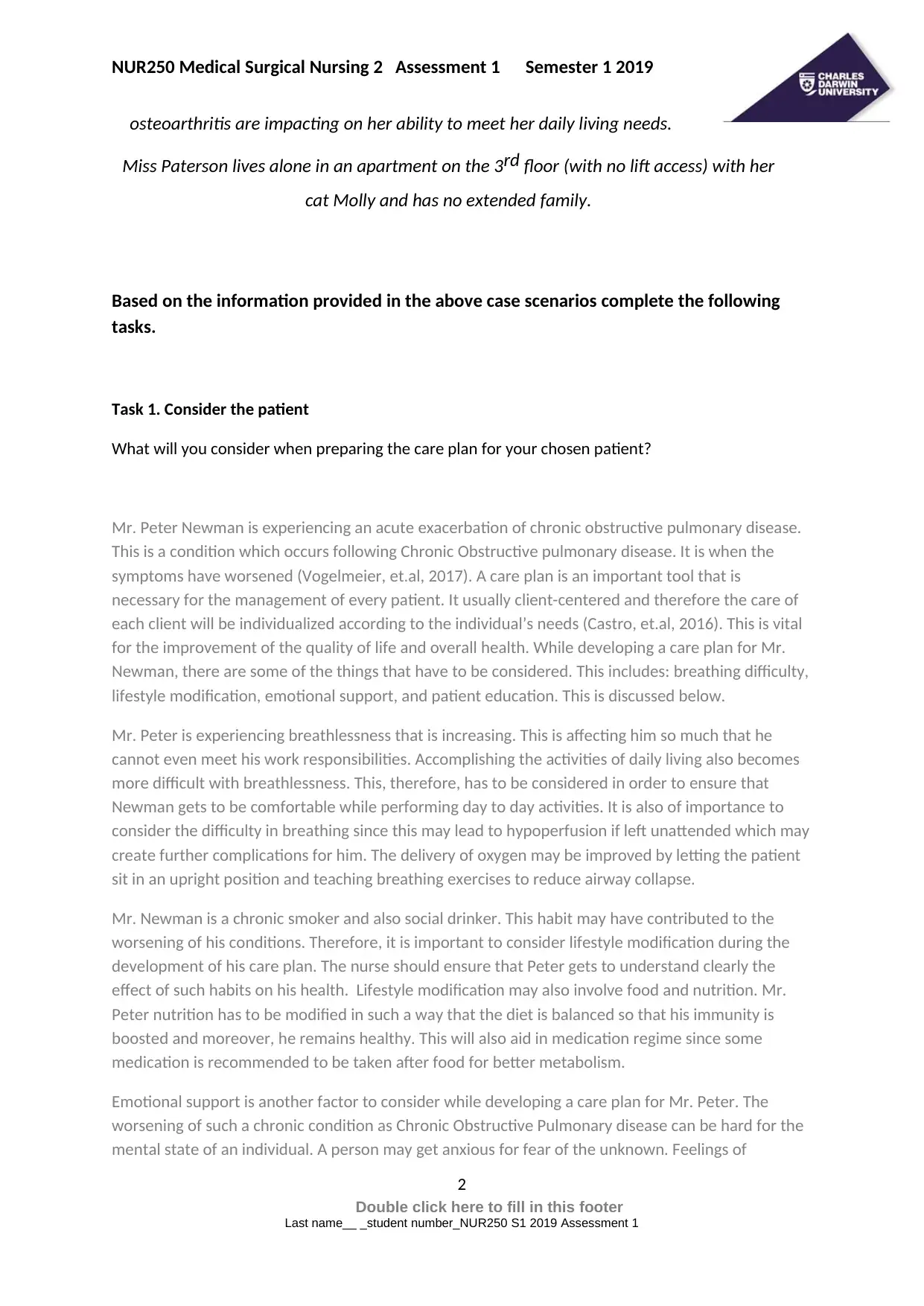
NUR250 Medical Surgical Nursing 2 Assessment 1 Semester 1 2019
osteoarthritis are impacting on her ability to meet her daily living needs.
Miss Paterson lives alone in an apartment on the 3rd floor (with no lift access) with her
cat Molly and has no extended family.
Based on the information provided in the above case scenarios complete the following
tasks.
Task 1. Consider the patient
What will you consider when preparing the care plan for your chosen patient?
Mr. Peter Newman is experiencing an acute exacerbation of chronic obstructive pulmonary disease.
This is a condition which occurs following Chronic Obstructive pulmonary disease. It is when the
symptoms have worsened (Vogelmeier, et.al, 2017). A care plan is an important tool that is
necessary for the management of every patient. It usually client-centered and therefore the care of
each client will be individualized according to the individual’s needs (Castro, et.al, 2016). This is vital
for the improvement of the quality of life and overall health. While developing a care plan for Mr.
Newman, there are some of the things that have to be considered. This includes: breathing difficulty,
lifestyle modification, emotional support, and patient education. This is discussed below.
Mr. Peter is experiencing breathlessness that is increasing. This is affecting him so much that he
cannot even meet his work responsibilities. Accomplishing the activities of daily living also becomes
more difficult with breathlessness. This, therefore, has to be considered in order to ensure that
Newman gets to be comfortable while performing day to day activities. It is also of importance to
consider the difficulty in breathing since this may lead to hypoperfusion if left unattended which may
create further complications for him. The delivery of oxygen may be improved by letting the patient
sit in an upright position and teaching breathing exercises to reduce airway collapse.
Mr. Newman is a chronic smoker and also social drinker. This habit may have contributed to the
worsening of his conditions. Therefore, it is important to consider lifestyle modification during the
development of his care plan. The nurse should ensure that Peter gets to understand clearly the
effect of such habits on his health. Lifestyle modification may also involve food and nutrition. Mr.
Peter nutrition has to be modified in such a way that the diet is balanced so that his immunity is
boosted and moreover, he remains healthy. This will also aid in medication regime since some
medication is recommended to be taken after food for better metabolism.
Emotional support is another factor to consider while developing a care plan for Mr. Peter. The
worsening of such a chronic condition as Chronic Obstructive Pulmonary disease can be hard for the
mental state of an individual. A person may get anxious for fear of the unknown. Feelings of
2
Double click here to fill in this footer
Last name__ _student number_NUR250 S1 2019 Assessment 1
osteoarthritis are impacting on her ability to meet her daily living needs.
Miss Paterson lives alone in an apartment on the 3rd floor (with no lift access) with her
cat Molly and has no extended family.
Based on the information provided in the above case scenarios complete the following
tasks.
Task 1. Consider the patient
What will you consider when preparing the care plan for your chosen patient?
Mr. Peter Newman is experiencing an acute exacerbation of chronic obstructive pulmonary disease.
This is a condition which occurs following Chronic Obstructive pulmonary disease. It is when the
symptoms have worsened (Vogelmeier, et.al, 2017). A care plan is an important tool that is
necessary for the management of every patient. It usually client-centered and therefore the care of
each client will be individualized according to the individual’s needs (Castro, et.al, 2016). This is vital
for the improvement of the quality of life and overall health. While developing a care plan for Mr.
Newman, there are some of the things that have to be considered. This includes: breathing difficulty,
lifestyle modification, emotional support, and patient education. This is discussed below.
Mr. Peter is experiencing breathlessness that is increasing. This is affecting him so much that he
cannot even meet his work responsibilities. Accomplishing the activities of daily living also becomes
more difficult with breathlessness. This, therefore, has to be considered in order to ensure that
Newman gets to be comfortable while performing day to day activities. It is also of importance to
consider the difficulty in breathing since this may lead to hypoperfusion if left unattended which may
create further complications for him. The delivery of oxygen may be improved by letting the patient
sit in an upright position and teaching breathing exercises to reduce airway collapse.
Mr. Newman is a chronic smoker and also social drinker. This habit may have contributed to the
worsening of his conditions. Therefore, it is important to consider lifestyle modification during the
development of his care plan. The nurse should ensure that Peter gets to understand clearly the
effect of such habits on his health. Lifestyle modification may also involve food and nutrition. Mr.
Peter nutrition has to be modified in such a way that the diet is balanced so that his immunity is
boosted and moreover, he remains healthy. This will also aid in medication regime since some
medication is recommended to be taken after food for better metabolism.
Emotional support is another factor to consider while developing a care plan for Mr. Peter. The
worsening of such a chronic condition as Chronic Obstructive Pulmonary disease can be hard for the
mental state of an individual. A person may get anxious for fear of the unknown. Feelings of
2
Double click here to fill in this footer
Last name__ _student number_NUR250 S1 2019 Assessment 1
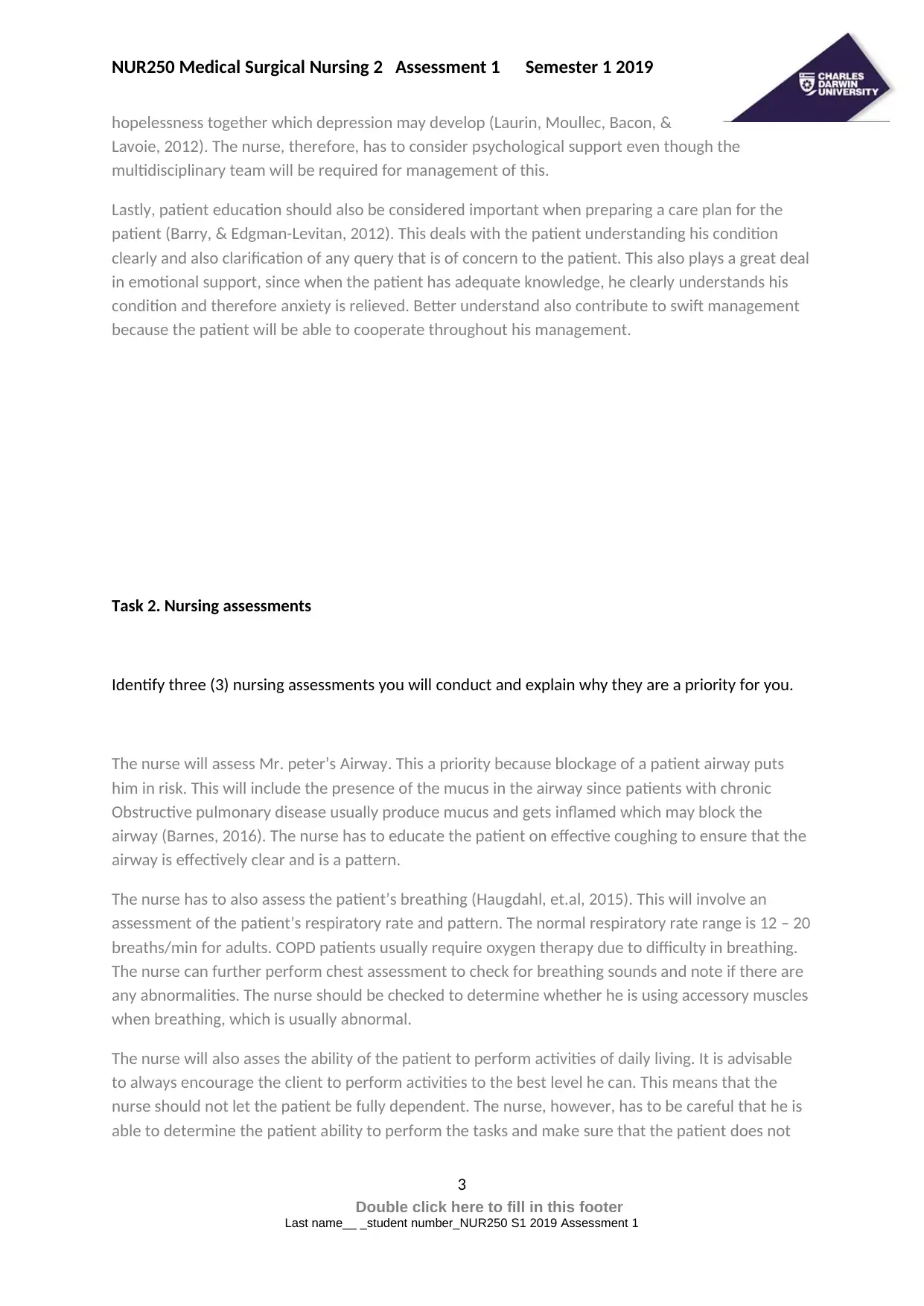
NUR250 Medical Surgical Nursing 2 Assessment 1 Semester 1 2019
hopelessness together which depression may develop (Laurin, Moullec, Bacon, &
Lavoie, 2012). The nurse, therefore, has to consider psychological support even though the
multidisciplinary team will be required for management of this.
Lastly, patient education should also be considered important when preparing a care plan for the
patient (Barry, & Edgman-Levitan, 2012). This deals with the patient understanding his condition
clearly and also clarification of any query that is of concern to the patient. This also plays a great deal
in emotional support, since when the patient has adequate knowledge, he clearly understands his
condition and therefore anxiety is relieved. Better understand also contribute to swift management
because the patient will be able to cooperate throughout his management.
Task 2. Nursing assessments
Identify three (3) nursing assessments you will conduct and explain why they are a priority for you.
The nurse will assess Mr. peter’s Airway. This a priority because blockage of a patient airway puts
him in risk. This will include the presence of the mucus in the airway since patients with chronic
Obstructive pulmonary disease usually produce mucus and gets inflamed which may block the
airway (Barnes, 2016). The nurse has to educate the patient on effective coughing to ensure that the
airway is effectively clear and is a pattern.
The nurse has to also assess the patient’s breathing (Haugdahl, et.al, 2015). This will involve an
assessment of the patient’s respiratory rate and pattern. The normal respiratory rate range is 12 – 20
breaths/min for adults. COPD patients usually require oxygen therapy due to difficulty in breathing.
The nurse can further perform chest assessment to check for breathing sounds and note if there are
any abnormalities. The nurse should be checked to determine whether he is using accessory muscles
when breathing, which is usually abnormal.
The nurse will also asses the ability of the patient to perform activities of daily living. It is advisable
to always encourage the client to perform activities to the best level he can. This means that the
nurse should not let the patient be fully dependent. The nurse, however, has to be careful that he is
able to determine the patient ability to perform the tasks and make sure that the patient does not
3
Double click here to fill in this footer
Last name__ _student number_NUR250 S1 2019 Assessment 1
hopelessness together which depression may develop (Laurin, Moullec, Bacon, &
Lavoie, 2012). The nurse, therefore, has to consider psychological support even though the
multidisciplinary team will be required for management of this.
Lastly, patient education should also be considered important when preparing a care plan for the
patient (Barry, & Edgman-Levitan, 2012). This deals with the patient understanding his condition
clearly and also clarification of any query that is of concern to the patient. This also plays a great deal
in emotional support, since when the patient has adequate knowledge, he clearly understands his
condition and therefore anxiety is relieved. Better understand also contribute to swift management
because the patient will be able to cooperate throughout his management.
Task 2. Nursing assessments
Identify three (3) nursing assessments you will conduct and explain why they are a priority for you.
The nurse will assess Mr. peter’s Airway. This a priority because blockage of a patient airway puts
him in risk. This will include the presence of the mucus in the airway since patients with chronic
Obstructive pulmonary disease usually produce mucus and gets inflamed which may block the
airway (Barnes, 2016). The nurse has to educate the patient on effective coughing to ensure that the
airway is effectively clear and is a pattern.
The nurse has to also assess the patient’s breathing (Haugdahl, et.al, 2015). This will involve an
assessment of the patient’s respiratory rate and pattern. The normal respiratory rate range is 12 – 20
breaths/min for adults. COPD patients usually require oxygen therapy due to difficulty in breathing.
The nurse can further perform chest assessment to check for breathing sounds and note if there are
any abnormalities. The nurse should be checked to determine whether he is using accessory muscles
when breathing, which is usually abnormal.
The nurse will also asses the ability of the patient to perform activities of daily living. It is advisable
to always encourage the client to perform activities to the best level he can. This means that the
nurse should not let the patient be fully dependent. The nurse, however, has to be careful that he is
able to determine the patient ability to perform the tasks and make sure that the patient does not
3
Double click here to fill in this footer
Last name__ _student number_NUR250 S1 2019 Assessment 1
⊘ This is a preview!⊘
Do you want full access?
Subscribe today to unlock all pages.

Trusted by 1+ million students worldwide
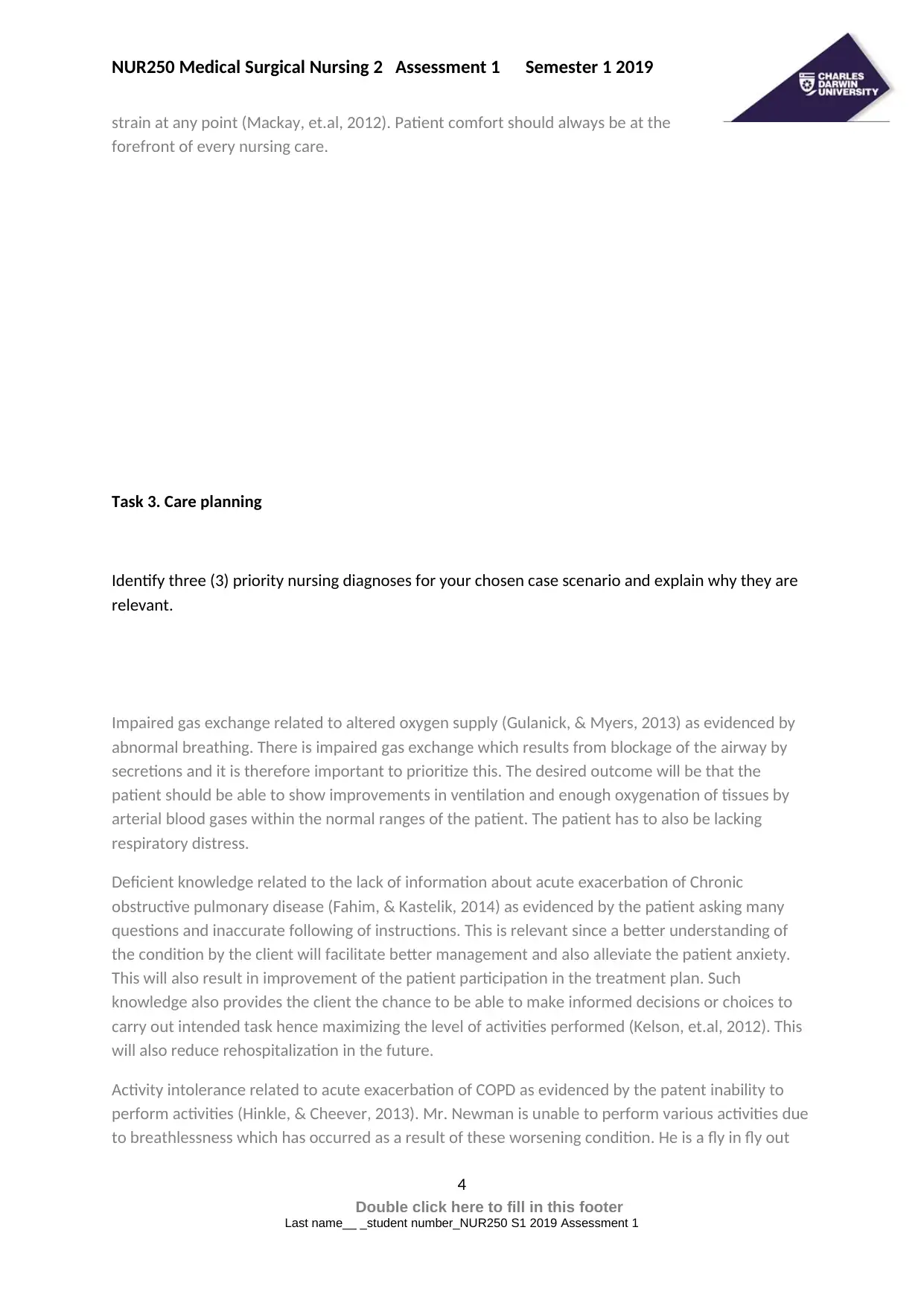
NUR250 Medical Surgical Nursing 2 Assessment 1 Semester 1 2019
strain at any point (Mackay, et.al, 2012). Patient comfort should always be at the
forefront of every nursing care.
Task 3. Care planning
Identify three (3) priority nursing diagnoses for your chosen case scenario and explain why they are
relevant.
Impaired gas exchange related to altered oxygen supply (Gulanick, & Myers, 2013) as evidenced by
abnormal breathing. There is impaired gas exchange which results from blockage of the airway by
secretions and it is therefore important to prioritize this. The desired outcome will be that the
patient should be able to show improvements in ventilation and enough oxygenation of tissues by
arterial blood gases within the normal ranges of the patient. The patient has to also be lacking
respiratory distress.
Deficient knowledge related to the lack of information about acute exacerbation of Chronic
obstructive pulmonary disease (Fahim, & Kastelik, 2014) as evidenced by the patient asking many
questions and inaccurate following of instructions. This is relevant since a better understanding of
the condition by the client will facilitate better management and also alleviate the patient anxiety.
This will also result in improvement of the patient participation in the treatment plan. Such
knowledge also provides the client the chance to be able to make informed decisions or choices to
carry out intended task hence maximizing the level of activities performed (Kelson, et.al, 2012). This
will also reduce rehospitalization in the future.
Activity intolerance related to acute exacerbation of COPD as evidenced by the patent inability to
perform activities (Hinkle, & Cheever, 2013). Mr. Newman is unable to perform various activities due
to breathlessness which has occurred as a result of these worsening condition. He is a fly in fly out
4
Double click here to fill in this footer
Last name__ _student number_NUR250 S1 2019 Assessment 1
strain at any point (Mackay, et.al, 2012). Patient comfort should always be at the
forefront of every nursing care.
Task 3. Care planning
Identify three (3) priority nursing diagnoses for your chosen case scenario and explain why they are
relevant.
Impaired gas exchange related to altered oxygen supply (Gulanick, & Myers, 2013) as evidenced by
abnormal breathing. There is impaired gas exchange which results from blockage of the airway by
secretions and it is therefore important to prioritize this. The desired outcome will be that the
patient should be able to show improvements in ventilation and enough oxygenation of tissues by
arterial blood gases within the normal ranges of the patient. The patient has to also be lacking
respiratory distress.
Deficient knowledge related to the lack of information about acute exacerbation of Chronic
obstructive pulmonary disease (Fahim, & Kastelik, 2014) as evidenced by the patient asking many
questions and inaccurate following of instructions. This is relevant since a better understanding of
the condition by the client will facilitate better management and also alleviate the patient anxiety.
This will also result in improvement of the patient participation in the treatment plan. Such
knowledge also provides the client the chance to be able to make informed decisions or choices to
carry out intended task hence maximizing the level of activities performed (Kelson, et.al, 2012). This
will also reduce rehospitalization in the future.
Activity intolerance related to acute exacerbation of COPD as evidenced by the patent inability to
perform activities (Hinkle, & Cheever, 2013). Mr. Newman is unable to perform various activities due
to breathlessness which has occurred as a result of these worsening condition. He is a fly in fly out
4
Double click here to fill in this footer
Last name__ _student number_NUR250 S1 2019 Assessment 1
Paraphrase This Document
Need a fresh take? Get an instant paraphrase of this document with our AI Paraphraser
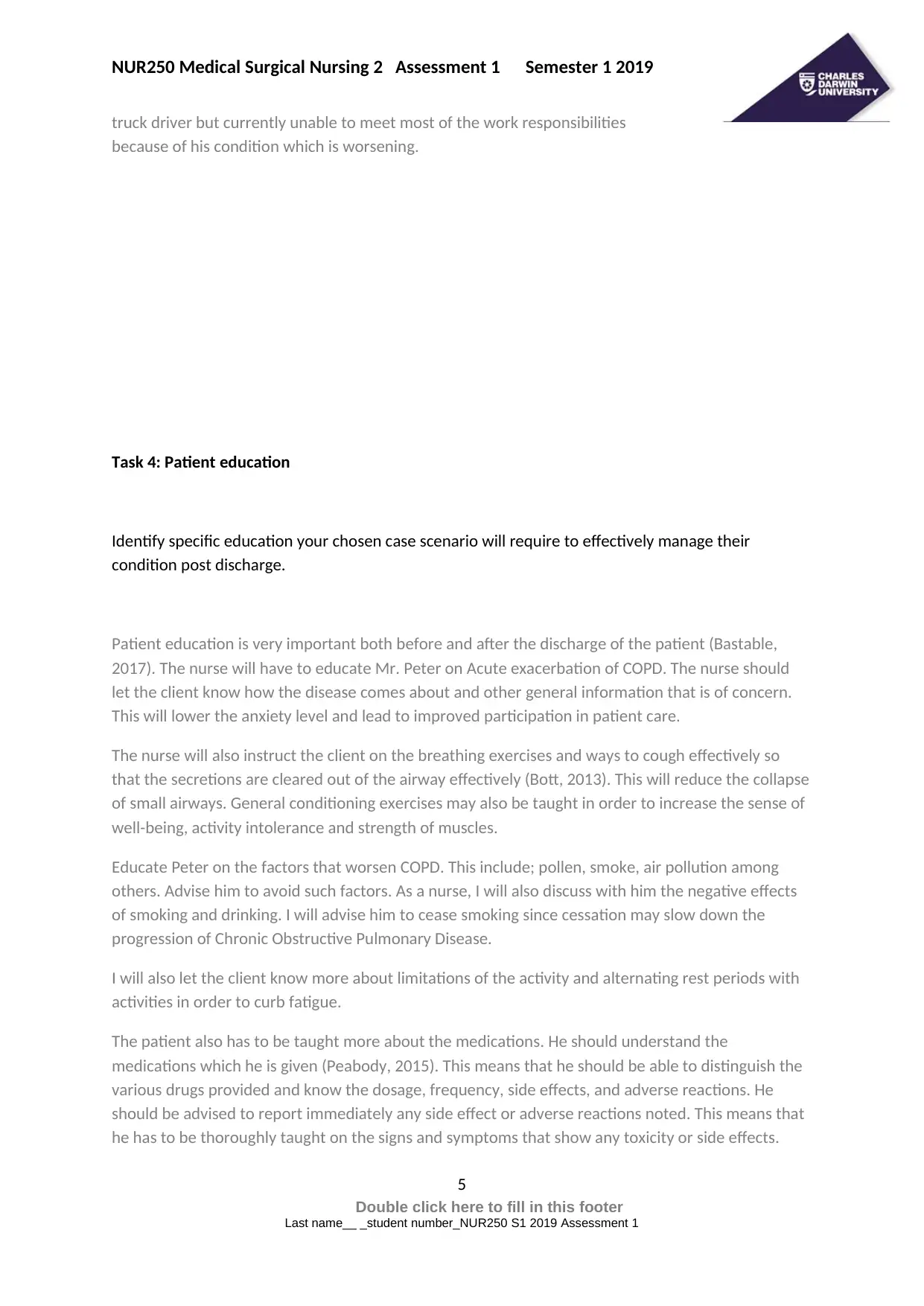
NUR250 Medical Surgical Nursing 2 Assessment 1 Semester 1 2019
truck driver but currently unable to meet most of the work responsibilities
because of his condition which is worsening.
Task 4: Patient education
Identify specific education your chosen case scenario will require to effectively manage their
condition post discharge.
Patient education is very important both before and after the discharge of the patient (Bastable,
2017). The nurse will have to educate Mr. Peter on Acute exacerbation of COPD. The nurse should
let the client know how the disease comes about and other general information that is of concern.
This will lower the anxiety level and lead to improved participation in patient care.
The nurse will also instruct the client on the breathing exercises and ways to cough effectively so
that the secretions are cleared out of the airway effectively (Bott, 2013). This will reduce the collapse
of small airways. General conditioning exercises may also be taught in order to increase the sense of
well-being, activity intolerance and strength of muscles.
Educate Peter on the factors that worsen COPD. This include; pollen, smoke, air pollution among
others. Advise him to avoid such factors. As a nurse, I will also discuss with him the negative effects
of smoking and drinking. I will advise him to cease smoking since cessation may slow down the
progression of Chronic Obstructive Pulmonary Disease.
I will also let the client know more about limitations of the activity and alternating rest periods with
activities in order to curb fatigue.
The patient also has to be taught more about the medications. He should understand the
medications which he is given (Peabody, 2015). This means that he should be able to distinguish the
various drugs provided and know the dosage, frequency, side effects, and adverse reactions. He
should be advised to report immediately any side effect or adverse reactions noted. This means that
he has to be thoroughly taught on the signs and symptoms that show any toxicity or side effects.
5
Double click here to fill in this footer
Last name__ _student number_NUR250 S1 2019 Assessment 1
truck driver but currently unable to meet most of the work responsibilities
because of his condition which is worsening.
Task 4: Patient education
Identify specific education your chosen case scenario will require to effectively manage their
condition post discharge.
Patient education is very important both before and after the discharge of the patient (Bastable,
2017). The nurse will have to educate Mr. Peter on Acute exacerbation of COPD. The nurse should
let the client know how the disease comes about and other general information that is of concern.
This will lower the anxiety level and lead to improved participation in patient care.
The nurse will also instruct the client on the breathing exercises and ways to cough effectively so
that the secretions are cleared out of the airway effectively (Bott, 2013). This will reduce the collapse
of small airways. General conditioning exercises may also be taught in order to increase the sense of
well-being, activity intolerance and strength of muscles.
Educate Peter on the factors that worsen COPD. This include; pollen, smoke, air pollution among
others. Advise him to avoid such factors. As a nurse, I will also discuss with him the negative effects
of smoking and drinking. I will advise him to cease smoking since cessation may slow down the
progression of Chronic Obstructive Pulmonary Disease.
I will also let the client know more about limitations of the activity and alternating rest periods with
activities in order to curb fatigue.
The patient also has to be taught more about the medications. He should understand the
medications which he is given (Peabody, 2015). This means that he should be able to distinguish the
various drugs provided and know the dosage, frequency, side effects, and adverse reactions. He
should be advised to report immediately any side effect or adverse reactions noted. This means that
he has to be thoroughly taught on the signs and symptoms that show any toxicity or side effects.
5
Double click here to fill in this footer
Last name__ _student number_NUR250 S1 2019 Assessment 1
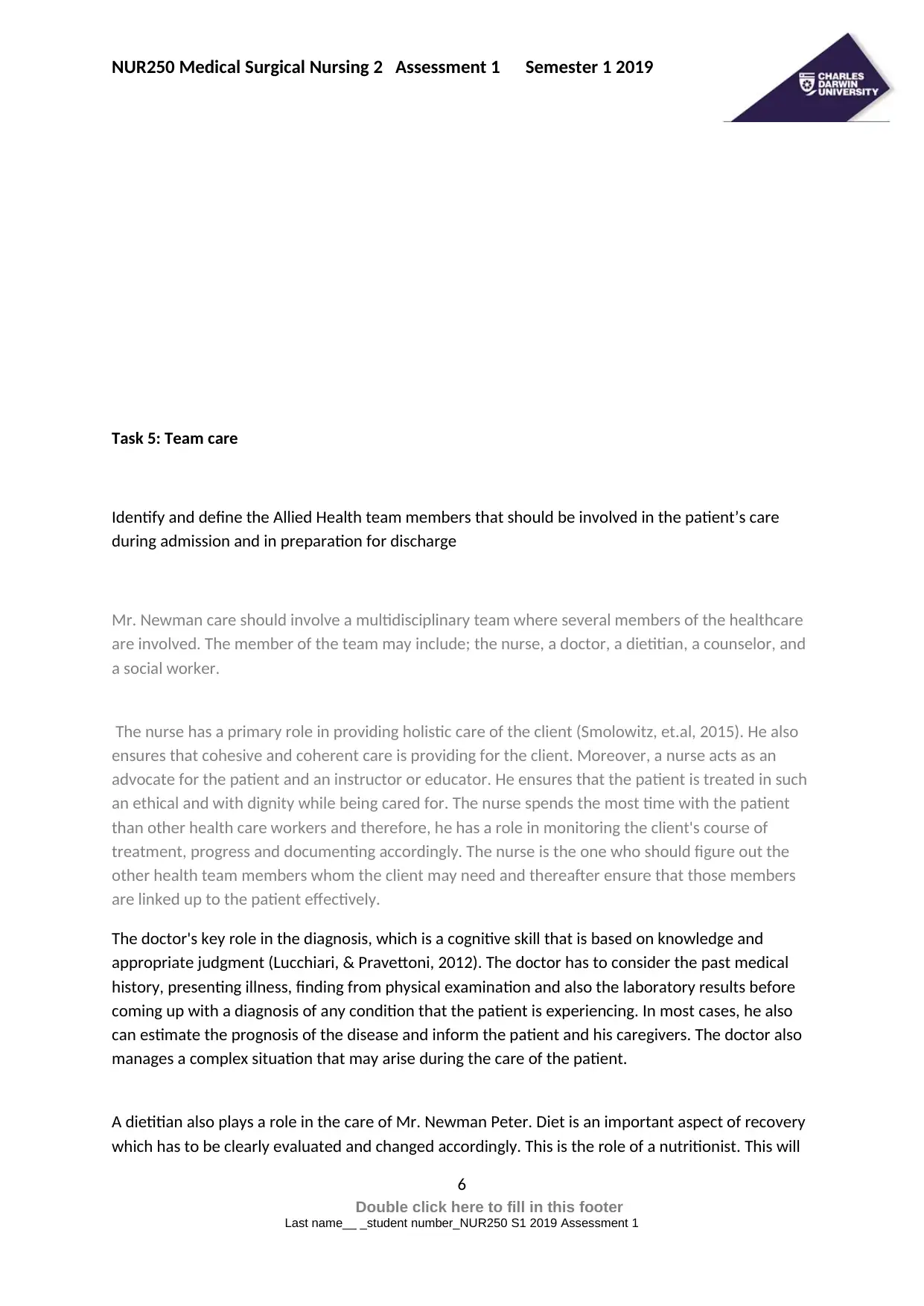
NUR250 Medical Surgical Nursing 2 Assessment 1 Semester 1 2019
Task 5: Team care
Identify and define the Allied Health team members that should be involved in the patient’s care
during admission and in preparation for discharge
Mr. Newman care should involve a multidisciplinary team where several members of the healthcare
are involved. The member of the team may include; the nurse, a doctor, a dietitian, a counselor, and
a social worker.
The nurse has a primary role in providing holistic care of the client (Smolowitz, et.al, 2015). He also
ensures that cohesive and coherent care is providing for the client. Moreover, a nurse acts as an
advocate for the patient and an instructor or educator. He ensures that the patient is treated in such
an ethical and with dignity while being cared for. The nurse spends the most time with the patient
than other health care workers and therefore, he has a role in monitoring the client's course of
treatment, progress and documenting accordingly. The nurse is the one who should figure out the
other health team members whom the client may need and thereafter ensure that those members
are linked up to the patient effectively.
The doctor's key role in the diagnosis, which is a cognitive skill that is based on knowledge and
appropriate judgment (Lucchiari, & Pravettoni, 2012). The doctor has to consider the past medical
history, presenting illness, finding from physical examination and also the laboratory results before
coming up with a diagnosis of any condition that the patient is experiencing. In most cases, he also
can estimate the prognosis of the disease and inform the patient and his caregivers. The doctor also
manages a complex situation that may arise during the care of the patient.
A dietitian also plays a role in the care of Mr. Newman Peter. Diet is an important aspect of recovery
which has to be clearly evaluated and changed accordingly. This is the role of a nutritionist. This will
6
Double click here to fill in this footer
Last name__ _student number_NUR250 S1 2019 Assessment 1
Task 5: Team care
Identify and define the Allied Health team members that should be involved in the patient’s care
during admission and in preparation for discharge
Mr. Newman care should involve a multidisciplinary team where several members of the healthcare
are involved. The member of the team may include; the nurse, a doctor, a dietitian, a counselor, and
a social worker.
The nurse has a primary role in providing holistic care of the client (Smolowitz, et.al, 2015). He also
ensures that cohesive and coherent care is providing for the client. Moreover, a nurse acts as an
advocate for the patient and an instructor or educator. He ensures that the patient is treated in such
an ethical and with dignity while being cared for. The nurse spends the most time with the patient
than other health care workers and therefore, he has a role in monitoring the client's course of
treatment, progress and documenting accordingly. The nurse is the one who should figure out the
other health team members whom the client may need and thereafter ensure that those members
are linked up to the patient effectively.
The doctor's key role in the diagnosis, which is a cognitive skill that is based on knowledge and
appropriate judgment (Lucchiari, & Pravettoni, 2012). The doctor has to consider the past medical
history, presenting illness, finding from physical examination and also the laboratory results before
coming up with a diagnosis of any condition that the patient is experiencing. In most cases, he also
can estimate the prognosis of the disease and inform the patient and his caregivers. The doctor also
manages a complex situation that may arise during the care of the patient.
A dietitian also plays a role in the care of Mr. Newman Peter. Diet is an important aspect of recovery
which has to be clearly evaluated and changed accordingly. This is the role of a nutritionist. This will
6
Double click here to fill in this footer
Last name__ _student number_NUR250 S1 2019 Assessment 1
⊘ This is a preview!⊘
Do you want full access?
Subscribe today to unlock all pages.

Trusted by 1+ million students worldwide

NUR250 Medical Surgical Nursing 2 Assessment 1 Semester 1 2019
help the patient maintain a healthy body and also boost the immunity hence
preventing further infections or complications (Tappenden, et.al, 2013). He should find out the
nutritional problems and assess the status of nutrition of the patient then come up with the diet
plan accordingly and educating the patient concerning special modification and the diet in general.
The counselor has a role to play in the emotional and psychological support of the Patient (Verwey,
et.al, 2014). Mr. Newman is suffering from a chronic condition which is getting worse. This will affect
his mental state. The disease has affected his job responsibilities and also his ability to perform
activities of daily living. He may start to feel hopeless and even get into depression. The counselor,
therefore, comes in hand to help him get through this psychological torture and be able to a life full
of hope and happiness.
Lastly, a social worker will also be of importantance in the care of Peter. A social worker collaborates
with other health care providers to address the psychosocial problems which the client may face.
Currently, Mr. Newman cannot meet his job responsibilities and he has a family to bring up and also
the hospital bill to settle. This may be really hard for him and this is why he will need a social worker
to facilitate him smoothly through the situation.
References
Barnes, P. J. (2016). Inflammatory mechanisms in patients with chronic obstructive pulmonary
disease. Journal of Allergy and Clinical Immunology, 138(1), 16-27.
Barry, M. J., & Edgman-Levitan, S. (2012). Shared decision making—the pinnacle of patient-centered
care. New England Journal of Medicine, 366(9), 780-781.
Bastable, S. B. (2017). Nurse as educator: Principles of teaching and learning for nursing practice.
Jones & Bartlett Learning.
Bott, J. (2013). Non-pharmacological management of breathlessness. Managing Breathlessness in
the Community, 113.
Castro, E. M., Van Regenmortel, T., Vanhaecht, K., Sermeus, W., & Van Hecke, A. (2016). Patient
empowerment, patient participation, and patient-centeredness in hospital care: a concept
analysis based on a literature review. Patient education and counseling, 99(12), 1923-1939.
7
Double click here to fill in this footer
Last name__ _student number_NUR250 S1 2019 Assessment 1
help the patient maintain a healthy body and also boost the immunity hence
preventing further infections or complications (Tappenden, et.al, 2013). He should find out the
nutritional problems and assess the status of nutrition of the patient then come up with the diet
plan accordingly and educating the patient concerning special modification and the diet in general.
The counselor has a role to play in the emotional and psychological support of the Patient (Verwey,
et.al, 2014). Mr. Newman is suffering from a chronic condition which is getting worse. This will affect
his mental state. The disease has affected his job responsibilities and also his ability to perform
activities of daily living. He may start to feel hopeless and even get into depression. The counselor,
therefore, comes in hand to help him get through this psychological torture and be able to a life full
of hope and happiness.
Lastly, a social worker will also be of importantance in the care of Peter. A social worker collaborates
with other health care providers to address the psychosocial problems which the client may face.
Currently, Mr. Newman cannot meet his job responsibilities and he has a family to bring up and also
the hospital bill to settle. This may be really hard for him and this is why he will need a social worker
to facilitate him smoothly through the situation.
References
Barnes, P. J. (2016). Inflammatory mechanisms in patients with chronic obstructive pulmonary
disease. Journal of Allergy and Clinical Immunology, 138(1), 16-27.
Barry, M. J., & Edgman-Levitan, S. (2012). Shared decision making—the pinnacle of patient-centered
care. New England Journal of Medicine, 366(9), 780-781.
Bastable, S. B. (2017). Nurse as educator: Principles of teaching and learning for nursing practice.
Jones & Bartlett Learning.
Bott, J. (2013). Non-pharmacological management of breathlessness. Managing Breathlessness in
the Community, 113.
Castro, E. M., Van Regenmortel, T., Vanhaecht, K., Sermeus, W., & Van Hecke, A. (2016). Patient
empowerment, patient participation, and patient-centeredness in hospital care: a concept
analysis based on a literature review. Patient education and counseling, 99(12), 1923-1939.
7
Double click here to fill in this footer
Last name__ _student number_NUR250 S1 2019 Assessment 1
Paraphrase This Document
Need a fresh take? Get an instant paraphrase of this document with our AI Paraphraser
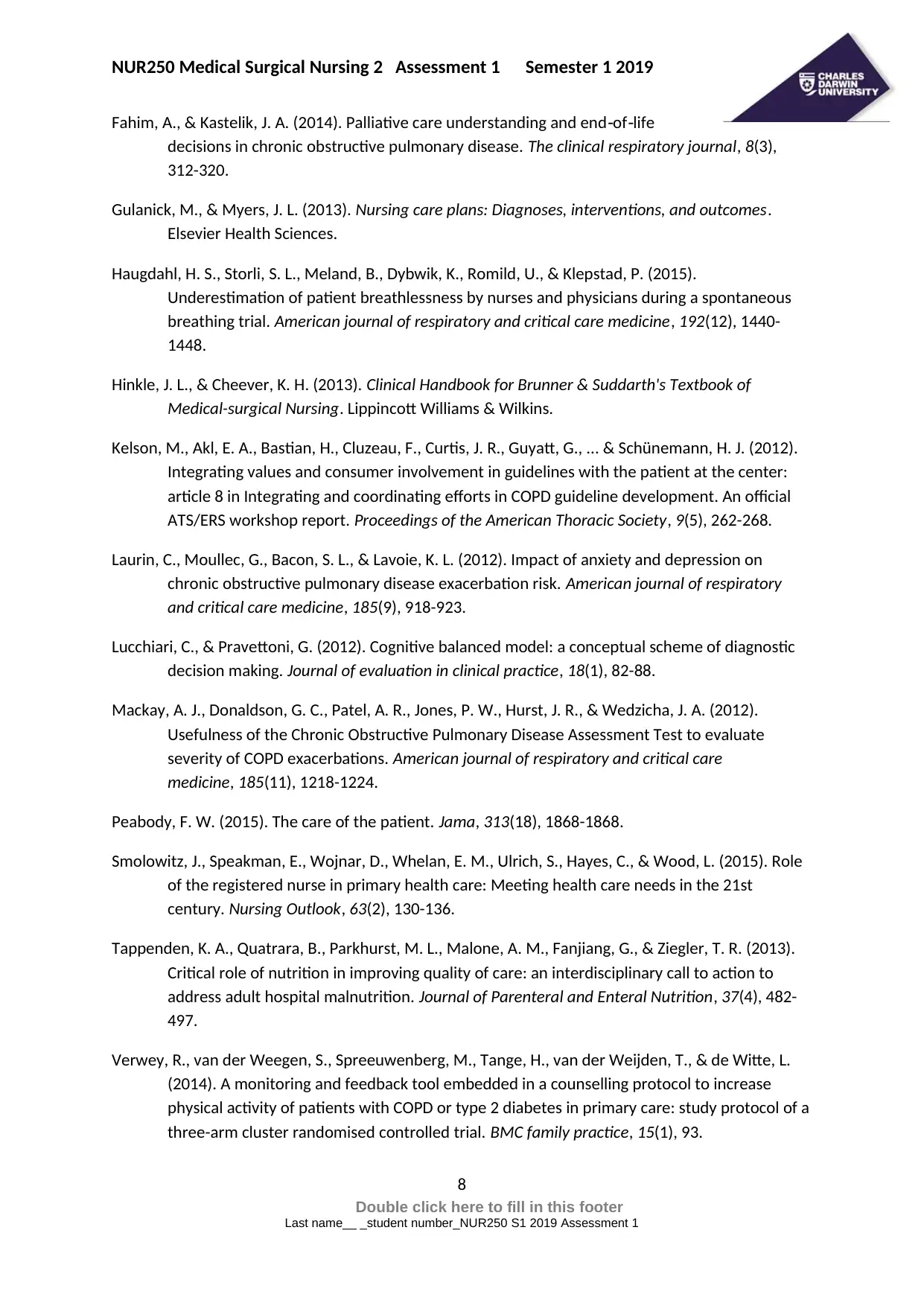
NUR250 Medical Surgical Nursing 2 Assessment 1 Semester 1 2019
Fahim, A., & Kastelik, J. A. (2014). Palliative care understanding and end of life‐ ‐
decisions in chronic obstructive pulmonary disease. The clinical respiratory journal, 8(3),
312-320.
Gulanick, M., & Myers, J. L. (2013). Nursing care plans: Diagnoses, interventions, and outcomes.
Elsevier Health Sciences.
Haugdahl, H. S., Storli, S. L., Meland, B., Dybwik, K., Romild, U., & Klepstad, P. (2015).
Underestimation of patient breathlessness by nurses and physicians during a spontaneous
breathing trial. American journal of respiratory and critical care medicine, 192(12), 1440-
1448.
Hinkle, J. L., & Cheever, K. H. (2013). Clinical Handbook for Brunner & Suddarth's Textbook of
Medical-surgical Nursing. Lippincott Williams & Wilkins.
Kelson, M., Akl, E. A., Bastian, H., Cluzeau, F., Curtis, J. R., Guyatt, G., ... & Schünemann, H. J. (2012).
Integrating values and consumer involvement in guidelines with the patient at the center:
article 8 in Integrating and coordinating efforts in COPD guideline development. An official
ATS/ERS workshop report. Proceedings of the American Thoracic Society, 9(5), 262-268.
Laurin, C., Moullec, G., Bacon, S. L., & Lavoie, K. L. (2012). Impact of anxiety and depression on
chronic obstructive pulmonary disease exacerbation risk. American journal of respiratory
and critical care medicine, 185(9), 918-923.
Lucchiari, C., & Pravettoni, G. (2012). Cognitive balanced model: a conceptual scheme of diagnostic
decision making. Journal of evaluation in clinical practice, 18(1), 82-88.
Mackay, A. J., Donaldson, G. C., Patel, A. R., Jones, P. W., Hurst, J. R., & Wedzicha, J. A. (2012).
Usefulness of the Chronic Obstructive Pulmonary Disease Assessment Test to evaluate
severity of COPD exacerbations. American journal of respiratory and critical care
medicine, 185(11), 1218-1224.
Peabody, F. W. (2015). The care of the patient. Jama, 313(18), 1868-1868.
Smolowitz, J., Speakman, E., Wojnar, D., Whelan, E. M., Ulrich, S., Hayes, C., & Wood, L. (2015). Role
of the registered nurse in primary health care: Meeting health care needs in the 21st
century. Nursing Outlook, 63(2), 130-136.
Tappenden, K. A., Quatrara, B., Parkhurst, M. L., Malone, A. M., Fanjiang, G., & Ziegler, T. R. (2013).
Critical role of nutrition in improving quality of care: an interdisciplinary call to action to
address adult hospital malnutrition. Journal of Parenteral and Enteral Nutrition, 37(4), 482-
497.
Verwey, R., van der Weegen, S., Spreeuwenberg, M., Tange, H., van der Weijden, T., & de Witte, L.
(2014). A monitoring and feedback tool embedded in a counselling protocol to increase
physical activity of patients with COPD or type 2 diabetes in primary care: study protocol of a
three-arm cluster randomised controlled trial. BMC family practice, 15(1), 93.
8
Double click here to fill in this footer
Last name__ _student number_NUR250 S1 2019 Assessment 1
Fahim, A., & Kastelik, J. A. (2014). Palliative care understanding and end of life‐ ‐
decisions in chronic obstructive pulmonary disease. The clinical respiratory journal, 8(3),
312-320.
Gulanick, M., & Myers, J. L. (2013). Nursing care plans: Diagnoses, interventions, and outcomes.
Elsevier Health Sciences.
Haugdahl, H. S., Storli, S. L., Meland, B., Dybwik, K., Romild, U., & Klepstad, P. (2015).
Underestimation of patient breathlessness by nurses and physicians during a spontaneous
breathing trial. American journal of respiratory and critical care medicine, 192(12), 1440-
1448.
Hinkle, J. L., & Cheever, K. H. (2013). Clinical Handbook for Brunner & Suddarth's Textbook of
Medical-surgical Nursing. Lippincott Williams & Wilkins.
Kelson, M., Akl, E. A., Bastian, H., Cluzeau, F., Curtis, J. R., Guyatt, G., ... & Schünemann, H. J. (2012).
Integrating values and consumer involvement in guidelines with the patient at the center:
article 8 in Integrating and coordinating efforts in COPD guideline development. An official
ATS/ERS workshop report. Proceedings of the American Thoracic Society, 9(5), 262-268.
Laurin, C., Moullec, G., Bacon, S. L., & Lavoie, K. L. (2012). Impact of anxiety and depression on
chronic obstructive pulmonary disease exacerbation risk. American journal of respiratory
and critical care medicine, 185(9), 918-923.
Lucchiari, C., & Pravettoni, G. (2012). Cognitive balanced model: a conceptual scheme of diagnostic
decision making. Journal of evaluation in clinical practice, 18(1), 82-88.
Mackay, A. J., Donaldson, G. C., Patel, A. R., Jones, P. W., Hurst, J. R., & Wedzicha, J. A. (2012).
Usefulness of the Chronic Obstructive Pulmonary Disease Assessment Test to evaluate
severity of COPD exacerbations. American journal of respiratory and critical care
medicine, 185(11), 1218-1224.
Peabody, F. W. (2015). The care of the patient. Jama, 313(18), 1868-1868.
Smolowitz, J., Speakman, E., Wojnar, D., Whelan, E. M., Ulrich, S., Hayes, C., & Wood, L. (2015). Role
of the registered nurse in primary health care: Meeting health care needs in the 21st
century. Nursing Outlook, 63(2), 130-136.
Tappenden, K. A., Quatrara, B., Parkhurst, M. L., Malone, A. M., Fanjiang, G., & Ziegler, T. R. (2013).
Critical role of nutrition in improving quality of care: an interdisciplinary call to action to
address adult hospital malnutrition. Journal of Parenteral and Enteral Nutrition, 37(4), 482-
497.
Verwey, R., van der Weegen, S., Spreeuwenberg, M., Tange, H., van der Weijden, T., & de Witte, L.
(2014). A monitoring and feedback tool embedded in a counselling protocol to increase
physical activity of patients with COPD or type 2 diabetes in primary care: study protocol of a
three-arm cluster randomised controlled trial. BMC family practice, 15(1), 93.
8
Double click here to fill in this footer
Last name__ _student number_NUR250 S1 2019 Assessment 1

NUR250 Medical Surgical Nursing 2 Assessment 1 Semester 1 2019
Vogelmeier, C. F., Criner, G. J., Martinez, F. J., Anzueto, A., Barnes, P. J., Bourbeau,
J., ... & Frith, P. (2017). Global strategy for the diagnosis, management, and prevention of
chronic obstructive lung disease 2017 report. GOLD executive summary. American journal of
respiratory and critical care medicine, 195(5), 557-582.
9
Double click here to fill in this footer
Last name__ _student number_NUR250 S1 2019 Assessment 1
Vogelmeier, C. F., Criner, G. J., Martinez, F. J., Anzueto, A., Barnes, P. J., Bourbeau,
J., ... & Frith, P. (2017). Global strategy for the diagnosis, management, and prevention of
chronic obstructive lung disease 2017 report. GOLD executive summary. American journal of
respiratory and critical care medicine, 195(5), 557-582.
9
Double click here to fill in this footer
Last name__ _student number_NUR250 S1 2019 Assessment 1
⊘ This is a preview!⊘
Do you want full access?
Subscribe today to unlock all pages.

Trusted by 1+ million students worldwide
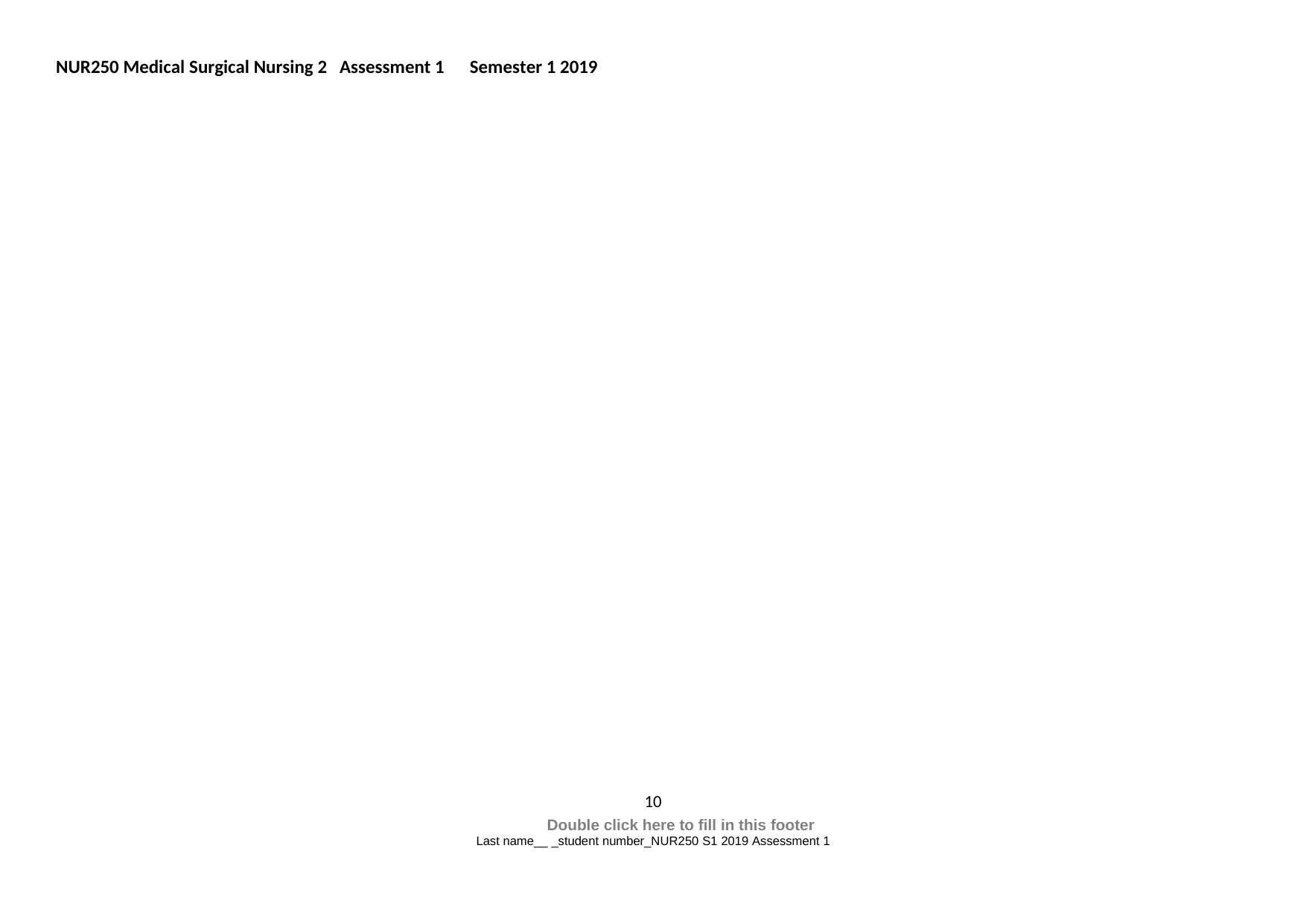
NUR250 Medical Surgical Nursing 2 Assessment 1 Semester 1 2019
10
Double click here to fill in this footer
Last name__ _student number_NUR250 S1 2019 Assessment 1
10
Double click here to fill in this footer
Last name__ _student number_NUR250 S1 2019 Assessment 1
1 out of 10
Related Documents
Your All-in-One AI-Powered Toolkit for Academic Success.
+13062052269
info@desklib.com
Available 24*7 on WhatsApp / Email
![[object Object]](/_next/static/media/star-bottom.7253800d.svg)
Unlock your academic potential
Copyright © 2020–2026 A2Z Services. All Rights Reserved. Developed and managed by ZUCOL.





